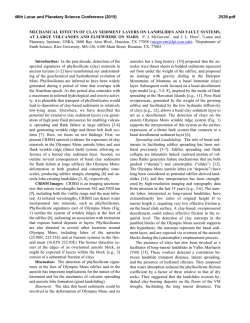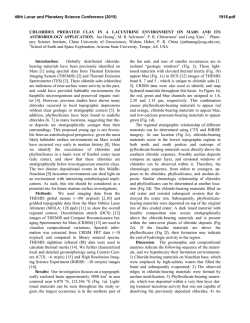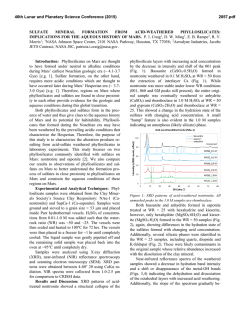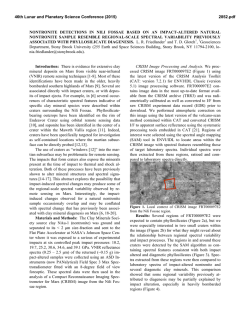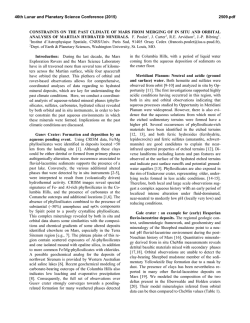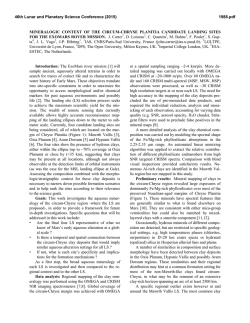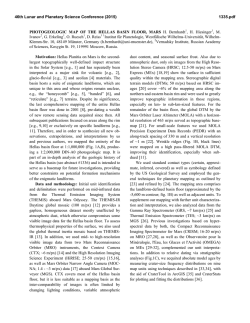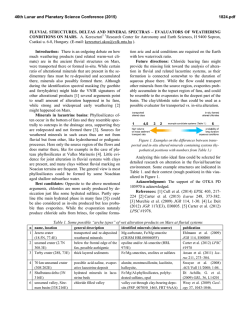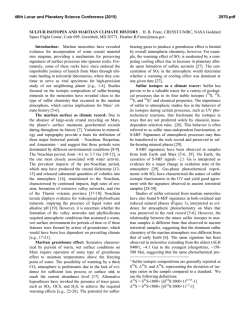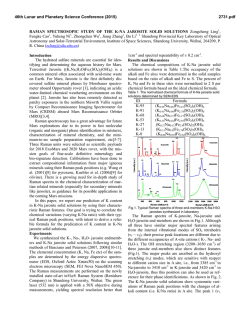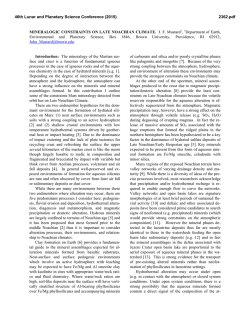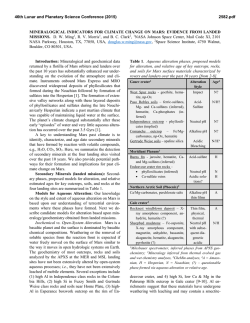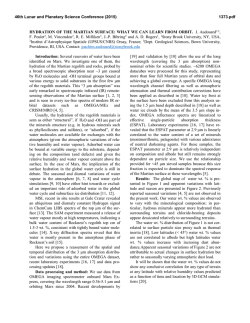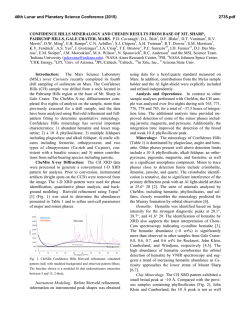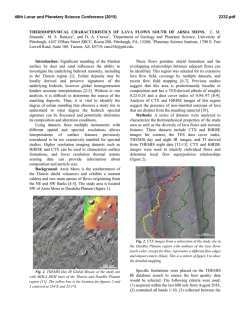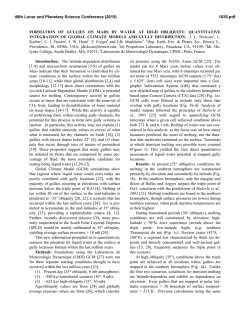
are noachian/hesperian acidic waters key to generating mars
46th Lunar and Planetary Science Conference (2015) 1635.pdf ARE NOACHIAN/HESPERIAN ACIDIC WATERS KEY TO GENERATING MARS’ REGIONAL-SCALE ALUMINUM PHYLLOSILICATES? THE IMPORTANCE OF JAROSITE CO-OCCURRENCES WITH AL-PHYLLOSILICATE UNITS. B. L. Ehlmann1,2 and M. Dundar3, 1Division of Geological and Planetary Science, California Institute of Technology, Pasadena, CA, USA ([email protected]). 2Jet Propulsion Laboratory, California Institute of Technology, Pasadena, CA, USA. 3Dept. of Computer & Information Science, Indiana University-Purdue University, Indianapolis, IN, USA Introduction: Compositionally stratified terrains with Al-phyllosilicates atop Fe/Mg-phyllosilicates have been found with orbital visible/shortwave infrared (VSWIR) imaging spectroscopy in several regions of Mars, at times with contiguous stratigraphy extending regionally over hundreds of thousands of kilometers [111]. Aluminum phyllosilicates can form from high water:rock ratio leaching of basaltic rocks, as products of alteration of siliceous precursors that can be less intenFigure 1. Two schematics for possible water chemistries and sive than those required for a basaltic protolith, or minerals formed during Al phyllosilicate formation. Whether or acidic alteration of rocks of any type [3-13] (Fig. 1). not waters were acidic is critical to understanding the habitaThe chemistry of the fluids and quantity and duration bility of the surface environment. of water involved dictates whether these environments indicating regionally or globally significant regions of were habitable. Geomorphological and mineralogical “acid Mars” during the late Noachian/early Hesperian. evidence has, to date, been equivocal in establishing Methods: Al phyllosilicates were first recognized the origins of Mars’ regional-scale Al phyllosilicatein Mars Express/OMEGA data [1] due to prominent bearing units. However, resolving the question of Al-OH absorptions at 1.40-1.41 µm and 2.20-2.21 µm origin is important because the stratigraphies with Al [17-18], which subsequent CRISM data showed comphyllosilicates occur preferentially in late Noachian prised a collection of multiple, discrete minerals with units but not earlier or later, at least at spatial scales different absorption band shapes and positions, includvisible from orbit. This suggests either wetter condiing montmorillonite [1], kaolinite [5,19], and beidellite tions and possibly a more clement climate enabling [20], sometimes with intermixed additional phases, near-surface water for alteration that was temporally perhaps silica [21]. These phases all map with the restricted to the late-Noachian/Hesperian boundary or a standard CRISM BD2200 parameter [22]. The paramebias in unit preservation [13]. ter formulation results also in mapping of other materiHere we re-examine the question of origin by conals with absorptions near 2.2 µm, such as gypsum, jarsideration of mineral assemblages within Al phyllosiliosite, and alunite. This lumping of discrete, environcate-bearing units (Fig. 1), using more advanced, automated tech- Figure 2. In several locations with the characteristic stratigraphy of Al phyllosilicates atop Fe/Mg niques for endmember discrimi- phyllosilicates, jarosite has been found in associationwith the Al-phyllosilicate unit (Fig. 3; 11; 25]. nation within high spatial resolu- Terra Sirenum hosts jarosite in sediments within paleolakes but it has not yet been found in plattion Compact Reconnaissance eau phyllosilicates. Libya Montes and Hellas are still to be examined in our global survey. Imaging Spectrometer for Mars (CRISM) VSWIR images [1415] combined with traditional mapping of absorption band strengths. We show that jarosite—an indicator mineral for acidic, oxidizing conditions—is common in several Al phyllosilicate deposits. This suggests that acidic waters, rather than simply intensive leaching from high throughput of near-surface waters, were importantl to the development of these stratigraphies, 46th Lunar and Planetary Science Conference (2015) mentally significant phases necessitates a new approach to exploration of spectral variability and recognition of mineral assemblages within the “Al phyllosilicate” units. In particular, driven by initial results [23] we have undertaken a systematic global search for the acid sulfate minerals alunite ((K,Na)Al3(SO4)2(OH)6) and jarosite ((K,Na, H3O+)Fe3(SO4)2(OH)6) within Al phyllosilicate-bearing units (Fig. 1). Alunite, jarosite, and intermediate phases in their solid solution have characteristic absorptions at 2.16 µm and 2.27 µm, respectively, that vary with cation substitution [24]. Areas with reported regional-scale occurrences of aluminum phyllosilicates were compiled from the literature [e.g. 10, 13]. CRISM L detector images were photometrically and atmospherically corrected using standard techniques [16]. Images were then processed to isolate endmembers using a non-parametric Bayesian clustering algorithm that can operate under weak assumptions regarding data characteristics and origin [14]. The algorithm divides each image data into several contiguous segments and analyzes all segments locally and jointly to identify spectral signatures representing endmembers, systematically using probabilistic sampling techniques. The underlying data model for each image segment is based upon the infinite mixture of infinitely many Gaussians, offering great flexibility in modeling skewed and multi-mode distributions [15]. Spectral signatures identified by this algorithm were cross-checked with existing VSWIR spectral libraries of minerals to identify phases and then spatially mapped using a custom parameter set. Results: As part of our new global survey we began with the Al phyllosilicate regional units for which 1635.pdf acid sulfates had not been reported and discovered 3 images with a dozen discrete outcrops showing evidence of jarosite co-occurrences with kaolin family minerals around Nili Fossae (e.g. Fig. 3). Jarosite has also been reported associated with plateau-style Al phyllosilicates at Mawrth Vallis [25] and in Valles Marineris [11], sometimes associated with silica instead [29]. Al phyllosilicates and jarosite are additionally found in paleolake sediments [26, 27] in Terra Sirenum, within Valles Marineris sediments [28]. Conclusions and Future Work: We will continue to systematically explore Al phyllosilicates above Fe/Mg phyllosilicates from the Martian rock record. Our initial data, coupled with the work of others [11, 25-29] suggests that these regional scale rock units may not merely reflect weathering sequences in a warm, wet early Mars climate, but rather the product of acidic (pH<4) waters interacting with the Martian surface. Future work will determine the implications for nearsurface habitability during the Noachian and Hesperian as our survey continues and the stratigraphic relationships between the Al-phyllosilicate and jarosite-bearing patches are refined at each locale. References: [1] Poulet et al., 2005, Nature [2] Loizeau et al., 2007, JGR [3] Bishop et al., 2008, Science [4] Wray et al., 2008, GRL [5] Ehlmann et al., 2009, JGR [6] Murchie et al., 2009, JGR [7] Loizeau et al., 2010, Icarus [8] Noe Dobrea et al., 2010, JGR [9] Carter et al., 2013, JGR [10] Loizeau & Carter, Mars 8, abs. #1203 [11] LeDeit et al., 2012, JGR [12] Horgan et al., LPSC 44, #3059 [13] Ehlmann et al., 2011, Nature [14] Dundar et al., 2014,BMC Bioinformatics [15] Yerebakan et al., 2014, NIPS [16] Murchie et al., 2009, JGR [17] Crowley & Vergo, 1988, Clays & Clay Min. [18] Clark et al., 1990, JGR [19] Mustard et al., 2008, Nature [20] Bishop et al., 2012 [21] McKeown et al., 2009, JGR [22] Pelkey et al., 2007, JGR [23] Dundar et al., 2013, IEEE WHISPERS [24] McCollom Figure 3. (a) map of mixed Al phyllosilicates and jarosite atop Fe/Mg phyllosilicates (R: BD2270, G: D2300. B: BD2200) (b, c) et al., 2014, Am. Min HiRISE PSP_006989_2025 and (d) spectra from the CRISM image and the USGS spectral library [30] [25] Farrand et al., 2009 ; 2014, Icarus [26] Swayze et al., 2007, Eos Trans. AGU 89(53) [27] Wray et al., 2011, JGR [28] Thollot et al., 2012, JGR [29] Milliken et al., 2008, Geology [30] Clark et al., 2007, USGS Spectral Library (online)
© Copyright 2025
